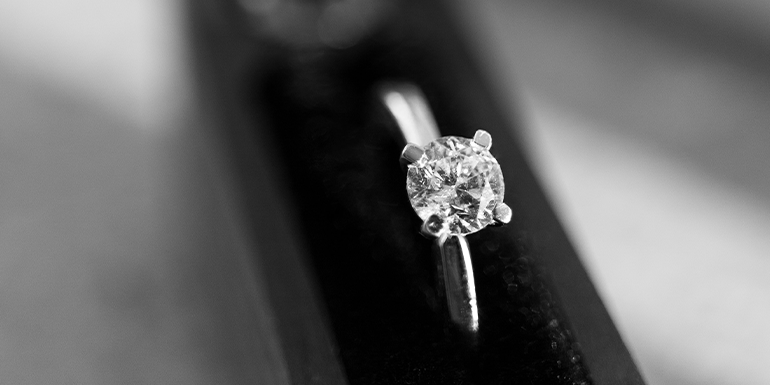People have always felt a need for self-immortalization. This theme isn’t something new, and evidence of its existence dates all the way back to before the Egyptians. It’s this ingrained desire for self-immortalization that has led to the development of creative burials, memorials, and other cultural practices regarding final disposition of a body.
Even though the methods of remembering a loved one and the aftercare of a body have changed drastically throughout the years, one thing has remained constant: people have always had a strong desire to be remembered. It’s not just the person who dies that wants to make sure their legacy carries on, but the bereaved friends and family who are left behind that also have a deep yearning to immortalize the memory of the deceased.
Jewelry that is dedicated to the memory of the deceased is a timeless choice for memorials because it can be passed on for generations. Thus, the loved one who passed away can carry on as part of the family for many years to come.
History of mourning jewelry
Mourning jewelry became popular during the 19th century. Queen Victoria famously started wearing memorial jewelry when she grieved the passing of Prince Albert. The trend took off like wildfire. Aristocrats and wealthy people started wearing necklaces, lockets, rings, and bracelets to pay tribute to their loved ones who passed away. Materials used during the period, that would be later called the “Victorian Era”, included:
- Pearls
- Onyx
- Dark turquoise shell
- Bog oak
- Jet
- Vulcanite
- Gutta-percha
As time passed, so did the types of memorial jewelry and the materials that were used to make it. Around the turn of the 21st century, cremation jewelry took the lead and is giving a facelift to designs of the past. One of the most interesting developments in the jewelry sector has been the development of gems grown from ashes.
What is a memorial diamond?
A memorial diamond is an authentic diamond that is grown in a unique process, in a laboratory setting, by extracting the pure carbon from the ashes of the deceased. These gemstones are also called cremation diamonds.
Elegant, innovative, and beautiful memorial diamonds have a lot to offer a person who is left broken-hearted after a loved one or a pet has died. However, because ashes are used in the creation process of these diamonds, there are a lot of questions about the ethics surrounding the method.
Concerns over memorial diamonds being seen as sacrilegious
Cremation as a process in general is already a conversation for many religious sects. The core of the issues with cremation being that in death our bodies can still be viewed as precious gifts that need to be left intact and some also anticipate to be resurrected.
In 2016 the head of the Catholic Church, the pope himself came out condemning ashes going anywhere but a sacred place, specifically condemning scattering, urns being kept at home and cremation jewelry.
Leaving the party responsible for the ashes with the distinct responsibility of knowing about the spiritual wants and needs of the departed. As cremation becomes increasingly popular many religious followers do not agree that memorial jewelry is an affront to their beliefs and like the idea of being a part of their loved ones lives via a piece of heritage jewelry. Ideally this should be noted in the will in advance though to prevent any confusion amongst loved ones.
Environmental and ethical issues solved with memorial diamonds
Mined diamonds are surrounded in controversy. The mining of diamonds can be linked to environmental degradation, exploitation of workers, and violence.
Natural diamonds have only been found in 35 countries. With most diamonds being mined in African countries which have not been able to implement strict regulation around the industry leading to many negative impacts in the areas where they are found. Diamonds found in areas that have been negatively affected by their being resurfaced are called conflict or blood diamonds.
While there are efforts to stop the negative impacts of diamonds, with conflict free diamonds gaining favor, the only 100% way to guarantee that gems are not involved is if they are synthetically produced. Making memorial diamonds a unique way to continue the enjoyment of the gem without the harmful global repercussions.
Legal issues around the right to commission a memorial diamond?
Before any planning for a cremation diamond can even commence, it must first be clearly established who has rights to the remains of a decedent. It can be a bit complicated because it’s very common for family members to have differing opinions on how a loved one’s body should be taken care of.
Country statutes are used to determine who has the first right to make decisions when the deceased did not leave a will behind that indicates their wishes. In the US, for example, Fifteen states have statues in place with a list of persons who have rights over the final remains, in order of their authority.
What happens when there is a conflict of interest?
Conflicts among family members regarding how the body is processed are, unfortunately, quite common. With famous family disputes such as Anna Nicole Smith or Boston Red Socks player Ted Williams, capturing media attention about disagreeing ideas around how the deceased should be laid to rest. How these cases are handled ultimately comes down to the local governments who will investigate the will and any evidence that indicates the departeds final wishes .
Memorial diamonds aide in the grieving process
The creation of gemstones from the ashes of a loved one is one beautiful way to keep their memory alive for many years to come. Those who have gone through with having a memorial diamond made say that the process of choosing all the options for the diamond and then finally receiving the jewelry helps them work through grief and that being able to wear the diamond makes them feel like the deceased is right there with them.
